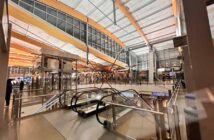
Glasgow International Airport, also known as GLA, serves as a key hub for Scotland, located just 15 kilometres west of Glasgow’s city centre in Paisley, Renfrewshire. Handling over 9 million passengers annually, it connects travellers to more than 120 destinations across Europe, North America, and the Middle East, with major airlines like easyJet, BA, and Loganair operating regular flights. Its single-terminal design and modern amenities ensure a smooth and enjoyable experience for those passing through.
The passenger experience at Glasgow Airport is designed for efficiency and comfort. The main terminal, Terminal 1, handles most flights, while Terminal 2 serves low-cost and charter airlines during peak periods. Check-in is straightforward, with 80 counters and self-service kiosks available, though some passengers note that kiosks can take 10–15 seconds to load pages, occasionally slowing the process.
Security screening, located on the first floor, is thorough, with advanced scanners requiring liquids and electronics to be removed, and queues can form during busy periods. Staff are generally courteous, and dedicated assistance for passengers with reduced mobility is available through pre-booked services, ensuring smooth navigation. Arrivals typically involve a short walk from the aircraft or a quick bus transfer, with clear signage guiding passengers to baggage claim or exits.
Accessing the airport is remarkably convenient, thanks to its direct connection to the M8 motorway and robust public transport options. The Glasgow Airport Express (Service 500) offers a 24/7 bus service to the city centre, reaching key stops like Buchanan Bus Station and Queen Street Station in 15–25 minutes for around £9. Buses depart every 10 minutes, equipped with free Wi-Fi and USB charging. Local buses, such as McGill’s 757, connect to Paisley Gilmour Street station in 10 minutes for £2–£3, where frequent trains reach Glasgow Central in 10–15 minutes.
Taxis and ride-sharing services like Uber and Bolt are available outside the terminal, with fares to the city centre averaging £20–£30. Car hire desks, including Avis, Europcar, and Hertz, are located in arrivals, and pre-booking is recommended. Motorway traffic or roadworks, particularly on North Hanover Street, can cause delays, so travellers should allow extra time.
The airport’s layout is intuitive, with Terminal 1 divided into three piers: West (International), Central, and East. The West Pier, equipped with air-bridges, handles long-haul flights, while the Central Pier, used primarily by BA, serves London routes. Terminal 2 is compact, with fewer gates for quick navigation. The ground floor houses check-in and baggage claim, while departures and dining are on the first floor. Digital flight information screens provide real-time updates, though seating can feel limited during peak times. Recent expansions, including a 2021 security hall upgrade, ensure efficient flow, with most gates within a 10-minute walk from security.
Delays are generally minimal, with an average additional arrival time of under three minutes, reflecting strong on-time performance. However, summer months and holiday periods, particularly July and August, see increased traffic, with weekends handling over 150,000 passengers. Weather conditions, such as fog or strong winds, and air traffic control strikes can cause disruptions, with easyJet reporting 60 delays and 92 cancellations in 2023. Passengers are advised to arrive two hours early for domestic flights and three for international to account for potential security or check-in queues.
Dining and retail options cater to diverse tastes. The departure lounge features eateries like The Gathering, offering Scottish-themed dishes, alongside fast-food outlets like McDonald’s and cafes like James Martin Kitchen. World Duty Free and smaller boutiques sell souvenirs, fashion, and travel essentials, with most outlets open from 4 am. to 9 pm. While options are ample, passengers with specific dietary needs may find choices limited, so planning ahead is wise.
Facilities enhance the travel experience. Free Wi-Fi is available for one hour, with a £2 premium option for faster access. Charging stations and wireless charging pillars are scattered throughout, and family-friendly amenities include baby-changing areas and a children’s play zone. The UpperDeck and Lomond Lounges offer quiet spaces with snacks and Wi-Fi for a fee, while a Changing Places facility supports passengers with disabilities. Baggage weighing stations, currency exchange, and a lost luggage desk add practicality. An observation deck provides runway views for enthusiasts.
For connections, Glasgow’s single-terminal setup simplifies transfers, with a recommended minimum connection time of 45 minutes for domestic and 90 minutes for international flights. Popular routes to London, Amsterdam, and Dublin facilitate easy connections, though self-transfers require clearing customs and security, so travellers should allow extra time. Weather-related delays or peak-time congestion can impact tight schedules, so checking flight status via the Glasgow Airport app is recommended.
Aer Lingus
Aer Lingus operates from the Main Terminal at Glasgow Airport for flights to Dublin. Check-in desks are typically in the Check-in Zone 1–20, but exact desks vary. Check-in opens 2 hours before departure and closes 45 minutes before departure. Online check-in is available 30 hours to 2 hours prior. Glasgow has frequent flights to Dublin, and passengers should arrive 90 minutes before departure.
Departures are usually from Gates 1–30 in the Main Terminal. Specific gates are assigned close to departure and displayed on airport screens.
Ryanair
Ryanair operates multiple daily flights to Dublin from Glasgow from the main terminal, with check-in desks typically in the check-in zone (desks 1–20). Exact desk numbers are displayed on airport screens. Bag drop opens 2 hours prior.
Departures are most commonly from gates 10-20 (dynamic for short-haul to Ireland; screens show ~40 minutes before departure).



